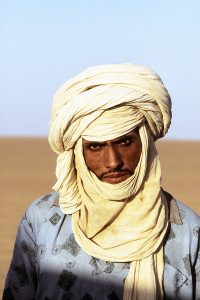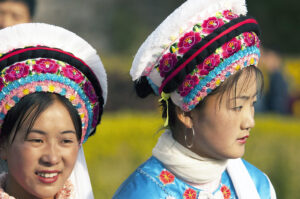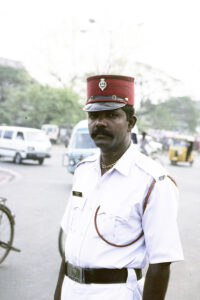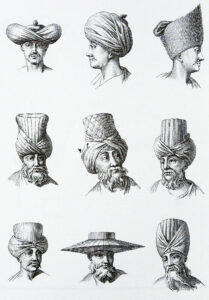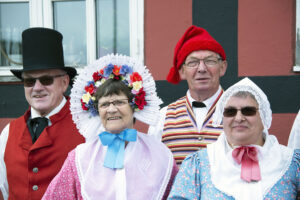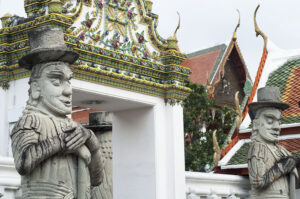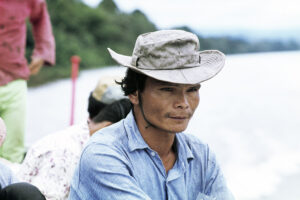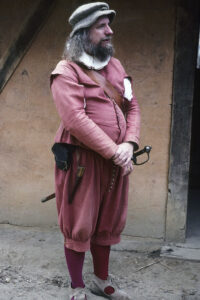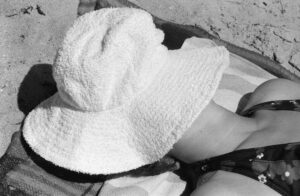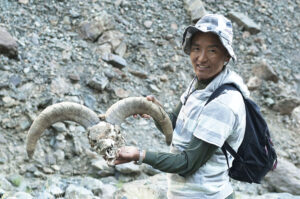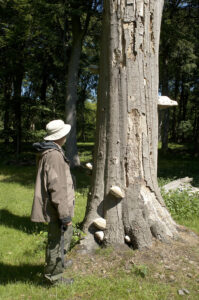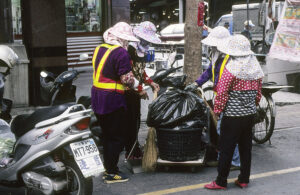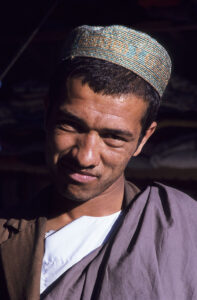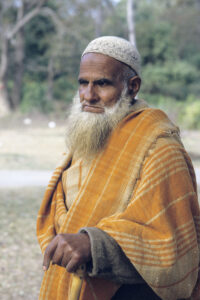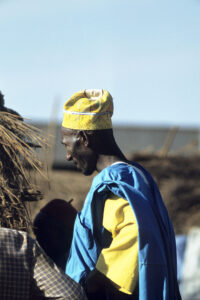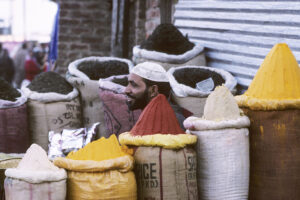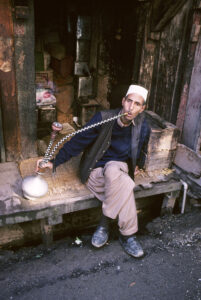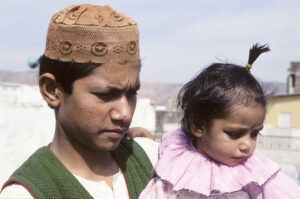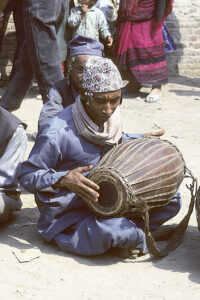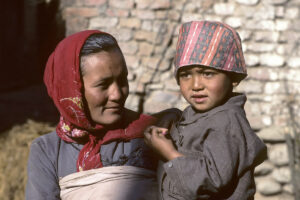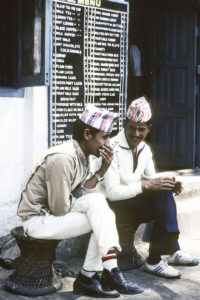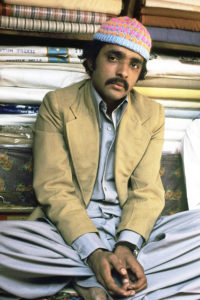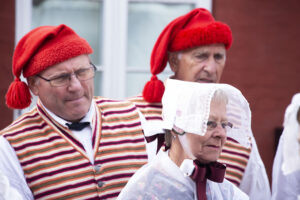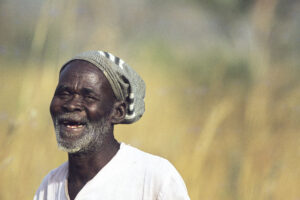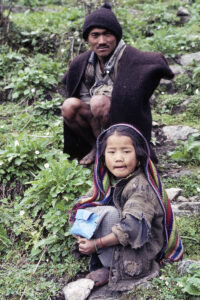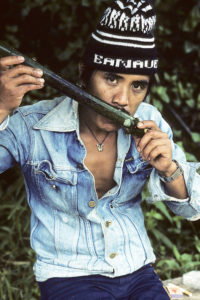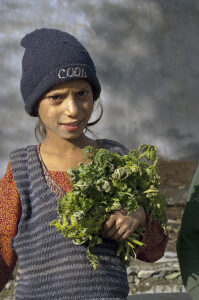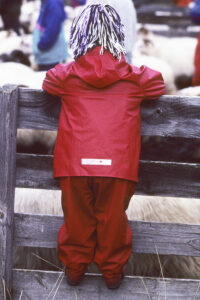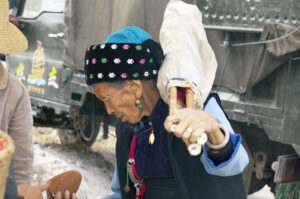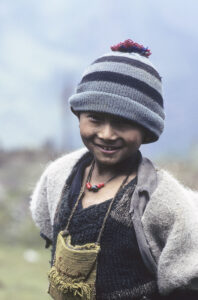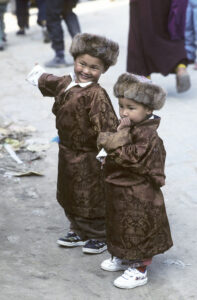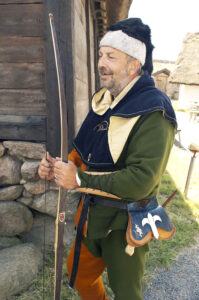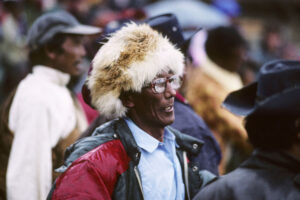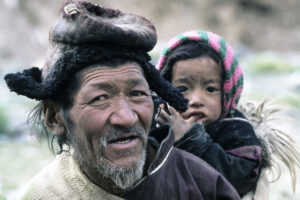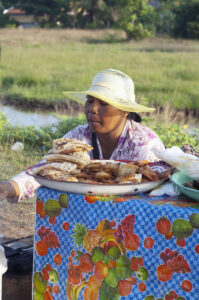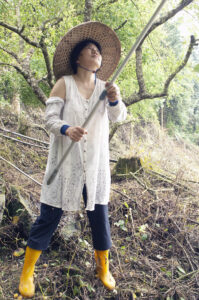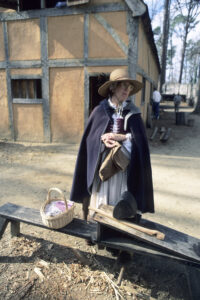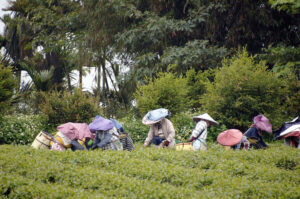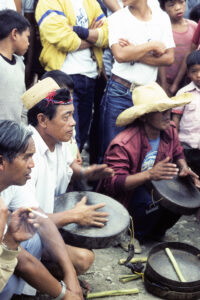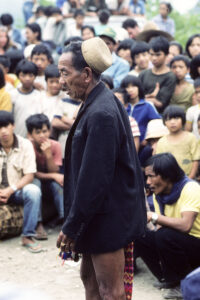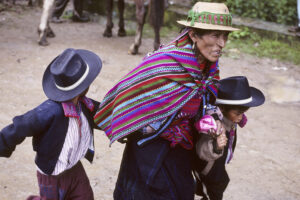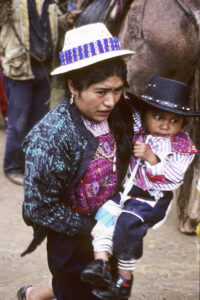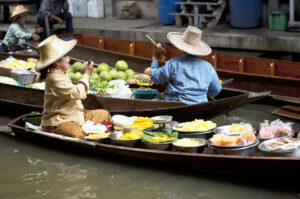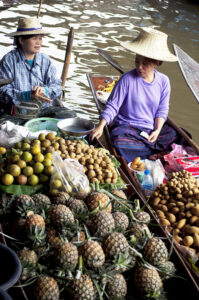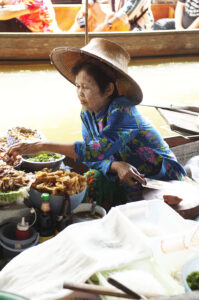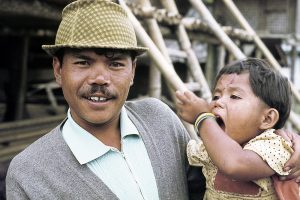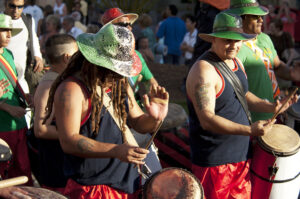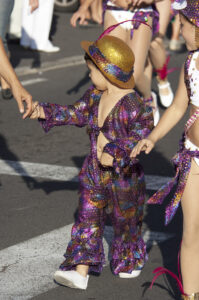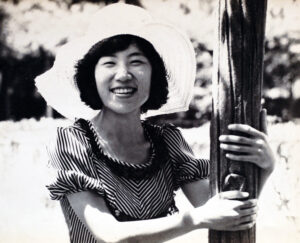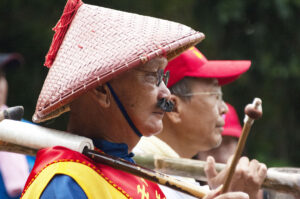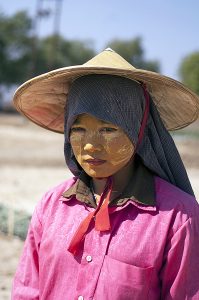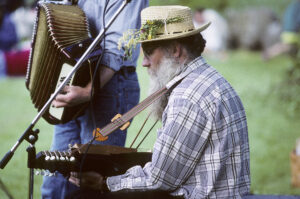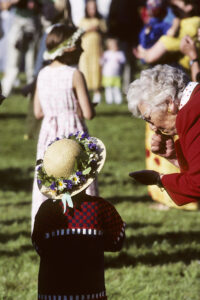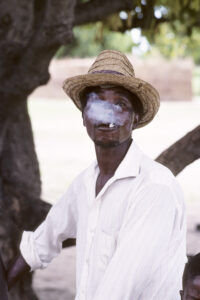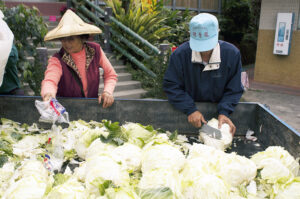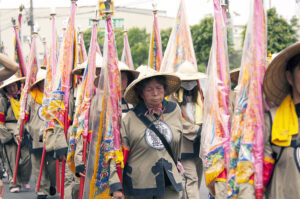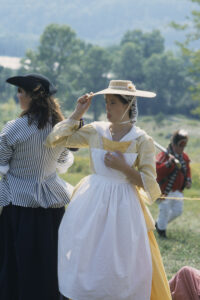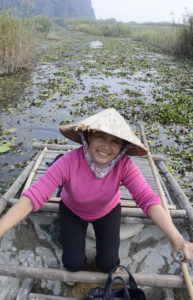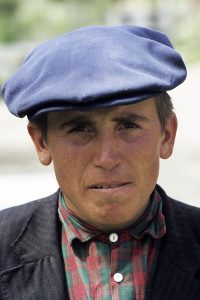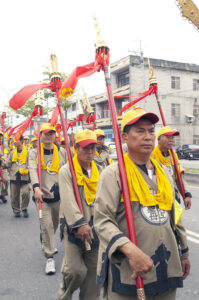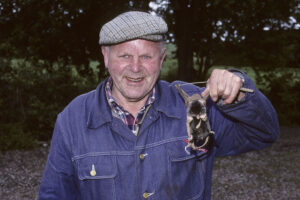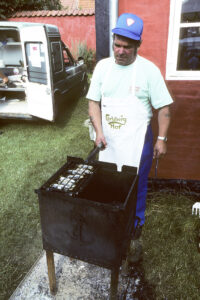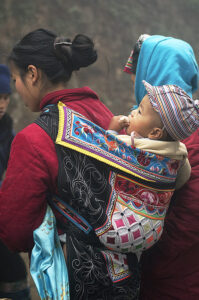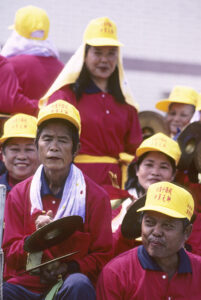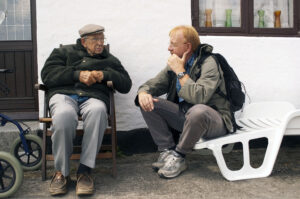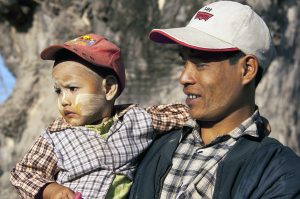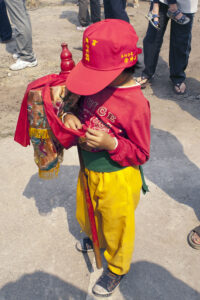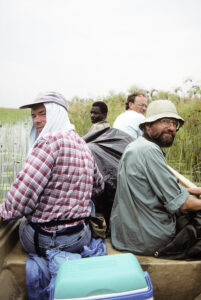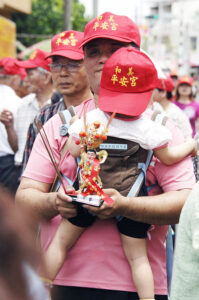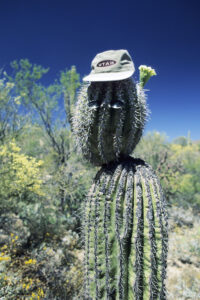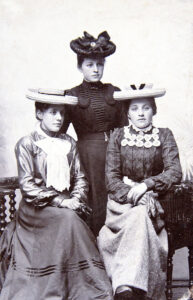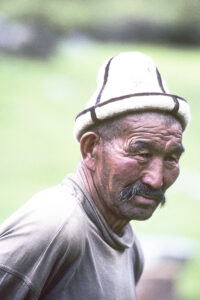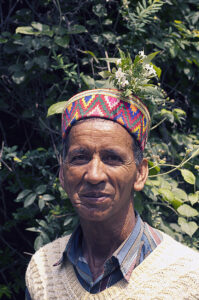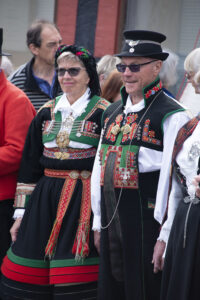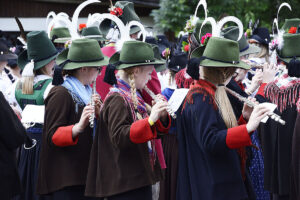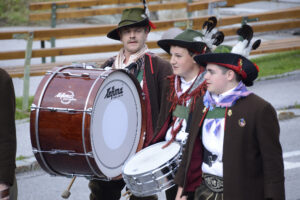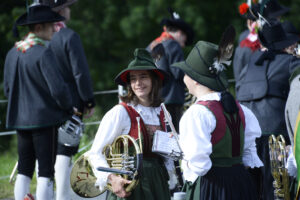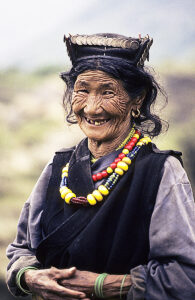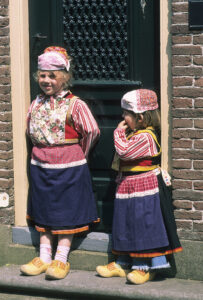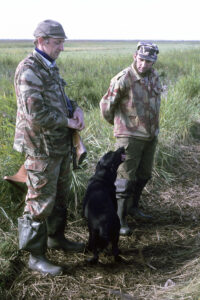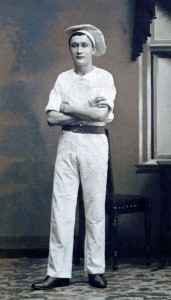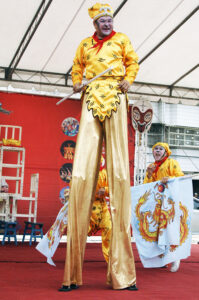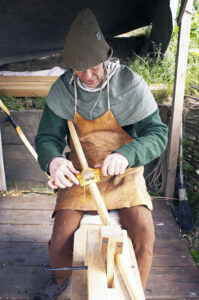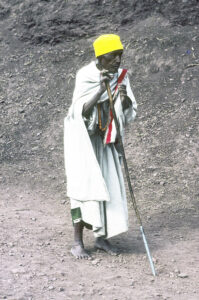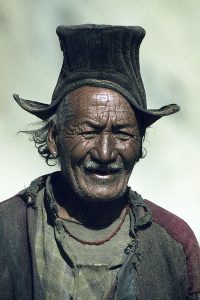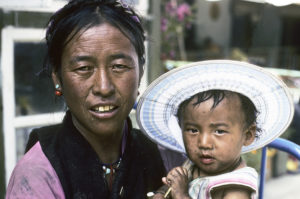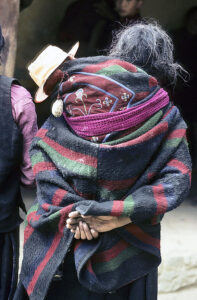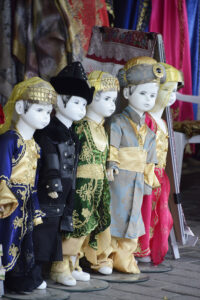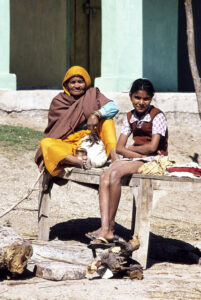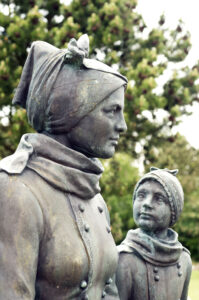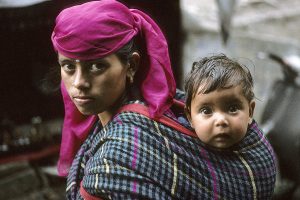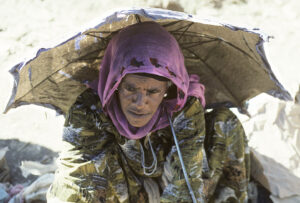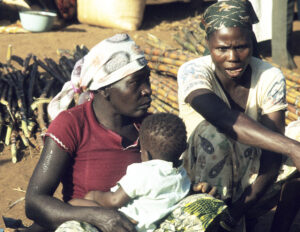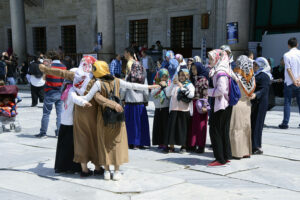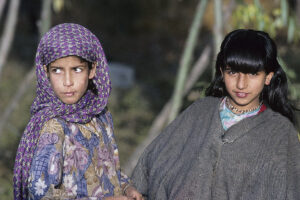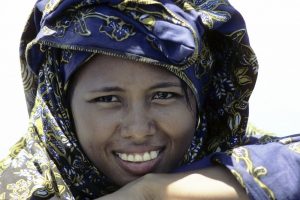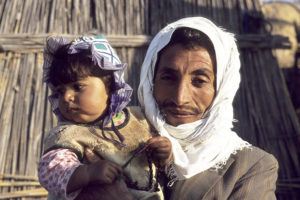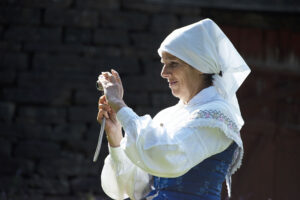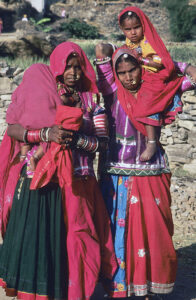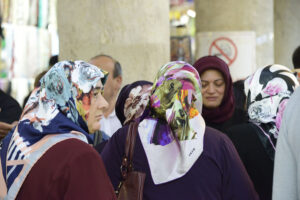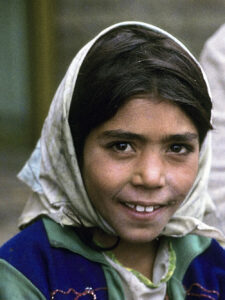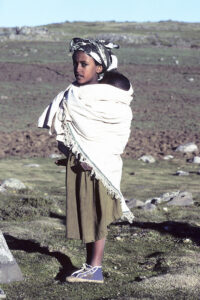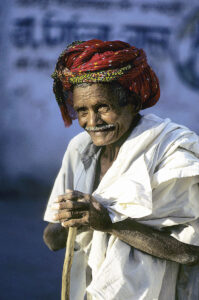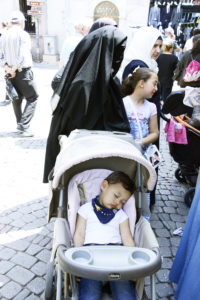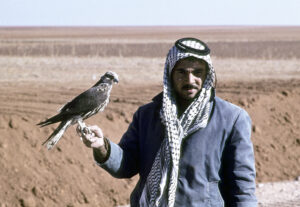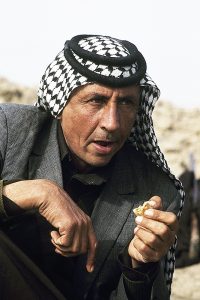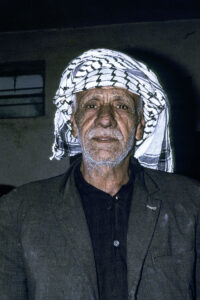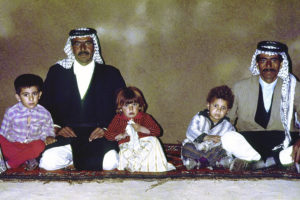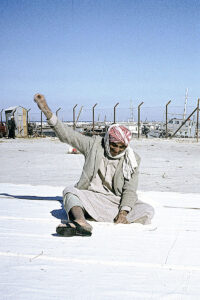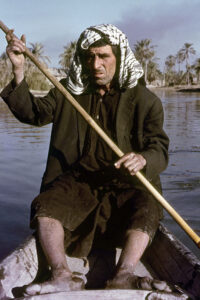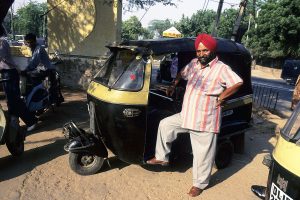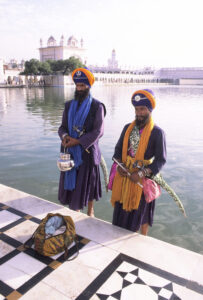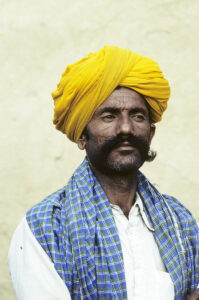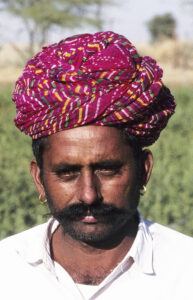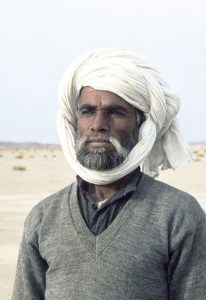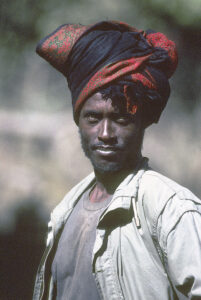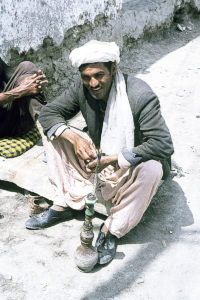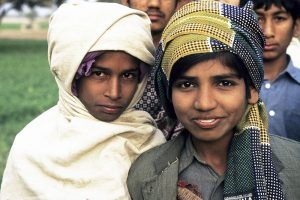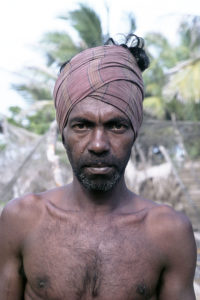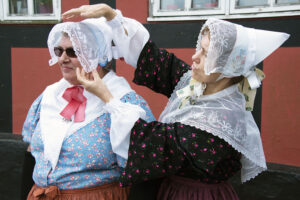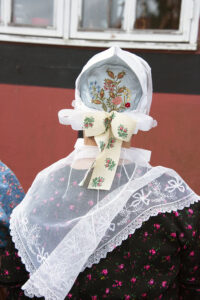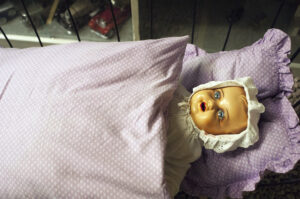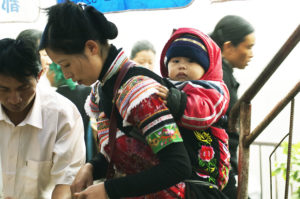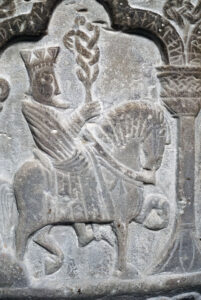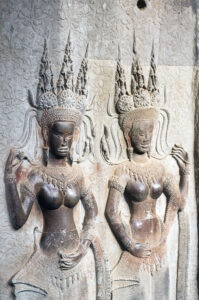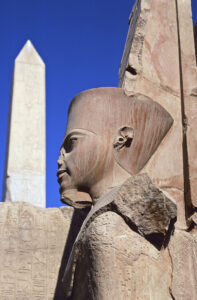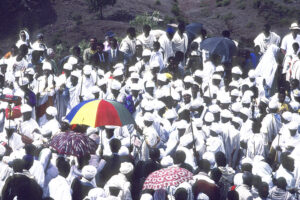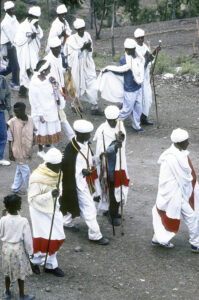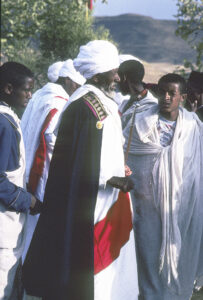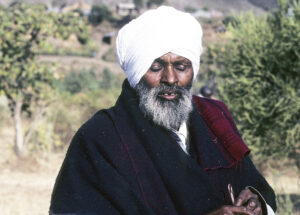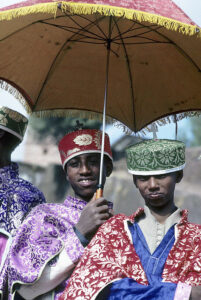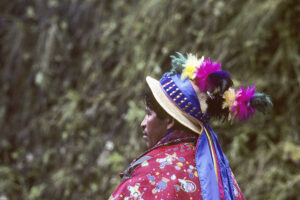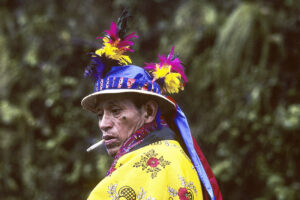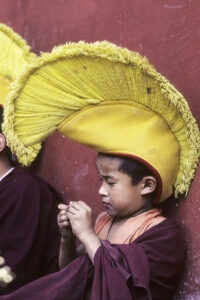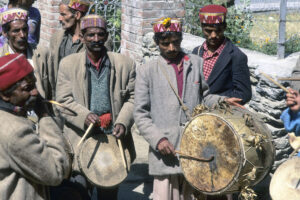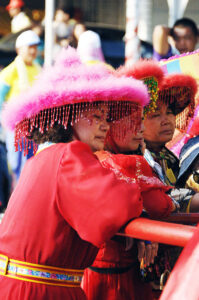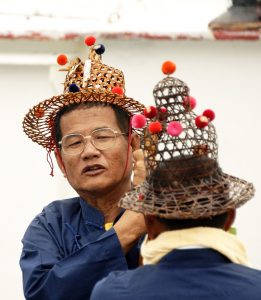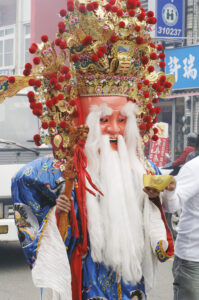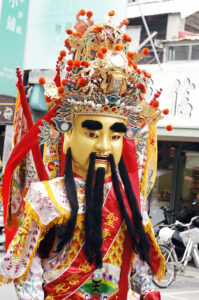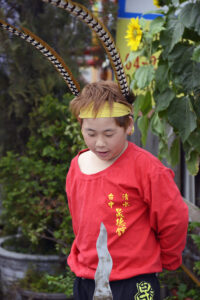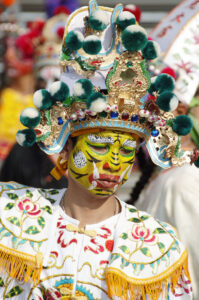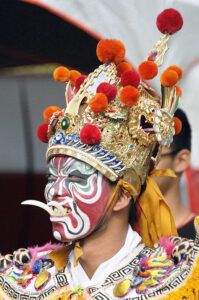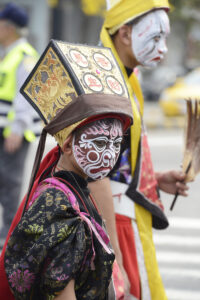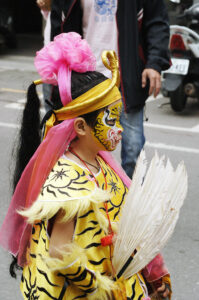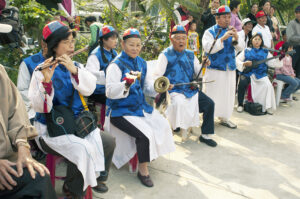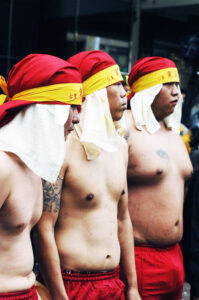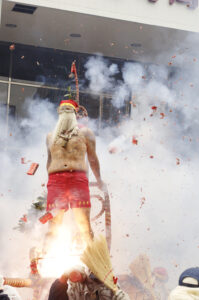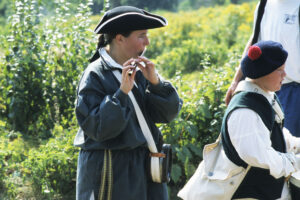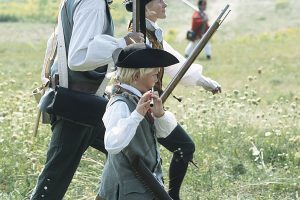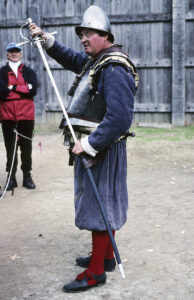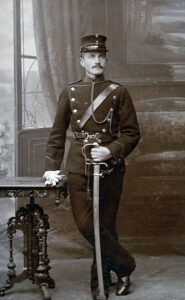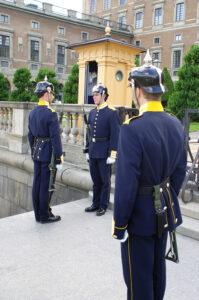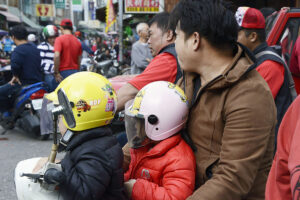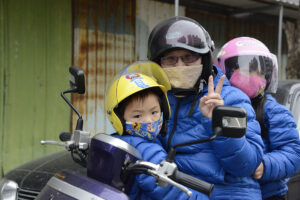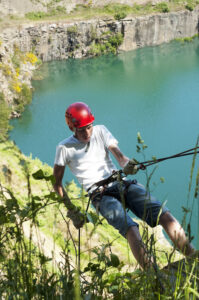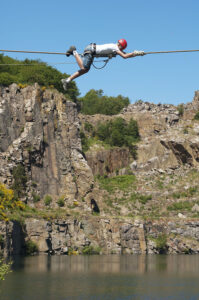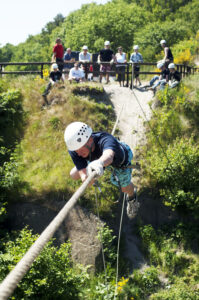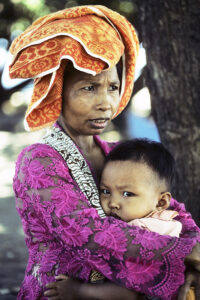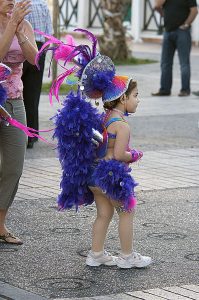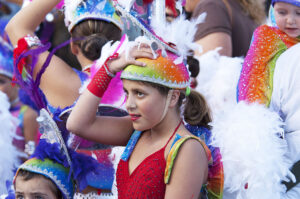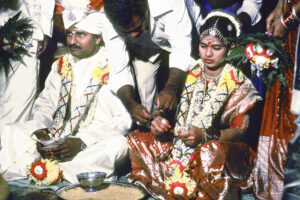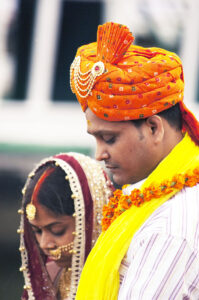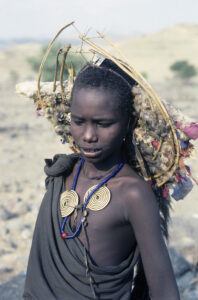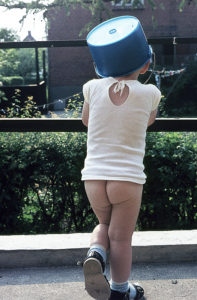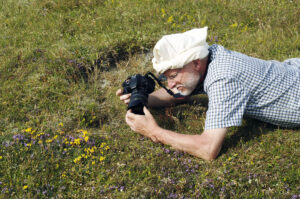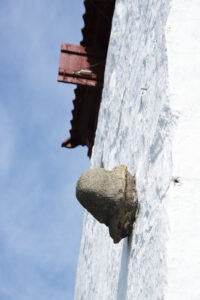Head dresses
The Tuaregs are a large group of Berber peoples, living in the western half of the Sahara Desert, southwards to Niger, Mali, and Burkina Faso. They have been dubbed ‘The Blue People’, because they dye their clothes with indigo, the blue colour of which stains their skin. I met this turban-clad Tuareg south of the town of Arlit, Niger. (Photo copyright © by Kaj Halberg)
The Yunnan Province of south-western China is home to at least 25 tribal peoples, who often wear very colourful traditional dresses. These young women of the Bai minority are posing for tourists in the city of Dali. (Photo copyright © by Kaj Halberg)
This Tamil policeman in Pondicherry (Puducherri), southern India, is wearing a French style police cap, called a kepi. This union territory was formerly a French colony. (Photo copyright © by Kaj Halberg)
Mother and child in the village of Changdam, Langtang Valley, Nepal. (Photo copyright © by Kaj Halberg)
Head dresses occur in a vast number of forms around the globe.
Various head dresses in Cairo, Egypt, drawn by German artist Georg Wilhelm Baurenfeind (1728-1763) during a Danish expedition to Arabia and other places 1761-1767, later dubbed ‘The Niebuhr Expedition’. This expedition is described in depth on the page People: Pehr Forsskål – brilliant Swedish scientist. (Illustrations: Public domain)
Top hat
This hat, also known as high hat or topper, is a tall, flat-crowned hat, usually black and often shining. It was typically worn by European and North American men, from the late 1700s to the early 1900s. Later, it has mostly been worn at solemn occasions, or at parties.
These people, wearing local dresses, are performing folk dances, Bornholm, Denmark. One man is wearing a top hat, the other knitwear, whereas the women wear bonnets (see below). (Photo copyright © by Kaj Halberg)
My father Jens Christen Pedersen was an apprentice in a co-op store in eastern Jutland, Denmark, 1935-1938. Before leaving the store, he was given a driver’s licence as a farewell gift, and for the occasion he is wearing a top hat. (Photo copyright © by Kaj Halberg)
After completing his master thesis in biology, my friend Jörn Eskildsen celebrated by giving a party, November 1979. This picture shows Jens Gregersen, wearing a top hat, Jörn, and Mogens Hansen. (Photo copyright © by Jörn Eskildsen)
Statues of temple guardians, wearing top hats, Wat Pho Temple, Bangkok, Thailand. (Photo copyright © by Kaj Halberg)
Bucket hat
A soft hat, usually made from cotton, with a round, flat crown and a wide, often downward-sloping brim. It is mostly used for sun protection.
This Dayak tribal was a passenger on board a ferry-canoe on the Rajang River, Sarawak, Borneo. (Photo copyright © by Kaj Halberg)
Danish ornithologist Knud Pedersen, photographing a common bird’s-foot trefoil (Lotus corniculatus), growing among cup lichens (Cladonia), Vendsyssel, Denmark. (Photo copyright © by Kaj Halberg)
This man at the Living Museum in Jamestown, Virginia, USA, is dressed in clothes, as they were in the 1600s, including a hat, which resembles a bucket hat. (Photo copyright © by Kaj Halberg)
Birthe Halberg enjoys the sunshine, but she doesn’t want it in her face, Jutland, Denmark. (Photo copyright © by Kaj Halberg)
My guide Karma Tsering, showing horns and skull of a bharal, or blue sheep (Pseudois nayaur), Ulley, Ladakh, India. (Photo copyright © by Kaj Halberg)
Hanne Højager, studying a dead beech (Fagus sylvatica) with many tinder polypores (Fomes fomentarius) on the trunk, Romsø, Funen, Denmark. (Photo copyright © by Kaj Halberg)
Wearing colourful buckets hats, these women are removing garbage from the street, Lugang, Taiwan. (Photo copyright © by Kaj Halberg)
Here I am at Ammarnäs, Lapland, Sweden, summer 1974. We were tortured by thousands of mosquitoes, which we attempted to avoid by walking into the centre of a large snowdrift. However, the mosquitoes just followed us! (Photo Jørn Halberg, copyright © by Kaj Halberg)
Fez
A short, cylindrical, peakless hat, usually made of felt, originally red and with a tassel attached to the top. The origin of the name is disputed, but may refer to the Moroccan city Fez. It is said that the dye to colour the hat was extracted in this city from crimson berries. The fez became a symbol of the Ottoman Empire in the early 19th Century, and it is still popular in Turkey.
The pictures below do not show the original fez, but fez-like hats.
Young man from Kandahar, Afghanistan. (Photo copyright © by Kaj Halberg)
Muslim Gujjar-Bakarwal nomad, Rajaji National Park, India. (Photo copyright © by Kaj Halberg)
This fez-like hat was observed at a market between Ngaunderé and Meiganga, Cameroun. (Photo copyright © by Kaj Halberg)
Shop-keeper, selling spices, Srinagar, Kashmir, India. (Photo copyright © by Kaj Halberg)
This shop-keeper in Srinagar is smoking on a hookah (waterpipe). (Photo copyright © by Kaj Halberg)
Islamic mullah (priest) in the city of Karakol, Kyrgyzstan, explaining the principles of Islam. (Photo copyright © by Kaj Halberg)
Sidis (Indian citizens of African descent), playing a musical instrument, called malunga, Zainabad, Gujarat, India. (Photo copyright © by Kaj Halberg)
Young Muslim with a little girl, Jaipur, Rajasthan, India. (Photo copyright © by Kaj Halberg)
Topi
This colourful hat resembles the fez in shape. It is the traditional hat of the Newar people of the Kathmandu Valley, Nepal.
Wearing a flower-decorated topi, this Newar-man is beating a tabla during the Hindu festival of Bisket Jatra, celebrated in the city of Bhaktapur, Kathmandu Valley. The tika mark on his forehead, consisting of a mixture of mustard oil and red powder, also contains rice kernels, indicating that an important festival is taking place. (Photo copyright © by Kaj Halberg)
Small Newar boy, wearing a topi, Kathmandu Valley. (Photo copyright © by Kaj Halberg)
Young men chatting, Kathmandu. (Photo copyright © by Kaj Halberg)
Knitwear
Cloth vendor, Kot Sabzal, Sind, Pakistan. (Photo copyright © by Kaj Halberg)
People, wearing local dress, perform folk dances, Bornholm, Denmark. (Photo copyright © by Kaj Halberg)
Bontoc tribal, attending a wedding fiest, Sagada, Luzon, Philippines. (Photo copyright © by Kaj Halberg)
Happy man, Kapsiki Mountains, Cameroun. (Photo copyright © by Kaj Halberg)
Sheep herders, father and daughter, Shunin Oral, Arun Valley, eastern Nepal. (Photo copyright © by Kaj Halberg)
During a forest walk, Mai Halberg has fallen asleep on her father Leif’s back, eastern Jutland, Denmark. (Photo copyright © by Kaj Halberg)
Hiking towards the Lamjura Pass in eastern Nepal, I passed these children, who were playing outside their home. As Nepalese children will often do, they shouted something after me. When I went up to photograph them, they suddenly became very silent, watching my doings with deep interest. (Photo copyright © by Kaj Halberg)
Joseph Blas, an Ifugao tribal in northern Luzon, Philippines, quenches his thirst by drinking the sap of a climber. (Photo copyright © by Kaj Halberg)
This girl from the village of Agora, Asi Ganga Valley, Uttarakhand, has been collecting ferns in the forest for her family’s evening meal. (Photo copyright © by Kaj Halberg)
This little girl is watching people rounding up sheep, Fnjóská, near Akureyri, Iceland. (Photo copyright © by Kaj Halberg)
An elderly tribal woman in traditional dress, shopping at a market, near Er Hai Lake, Yunnan Province, China. (Photo copyright © by Kaj Halberg)
Small herder, Tashigaon, Arun Valley. Around his neck, he is wearing a rosary and a talisman bag. (Photo copyright © by Kaj Halberg)
Fur hats
During Losar, the Tibetan New Year, these Tibetan boys, dressed in their best finery, pay a visit to the Bodhnath Stupa in Kathmandu, Nepal. Their hats are made from dog fur or the like. (Photo copyright © by Kaj Halberg)
This man at the Bornholm Middle Age Centre, Denmark, is dressed as a Middle Age archer. His head dress consists of a woollen hat and a dog fur. (Photo copyright © by Kaj Halberg)
During the Tibetan Yartung festival, this man pays a visit to the Muktinath Temple, Jhong River Valley, Mustang, Nepal. He is wearing a hat made from dog fur or the like. (Photo copyright © by Kaj Halberg)
Ældre mand med sit barnebarn, Markha-dalen, Ladakh, Indien. Hans hat er fremstillet af en fårepels. (Foto copyright © by Kaj Halberg)
Straw hats
Straw hats are typically worn for sun protection.
Khmer woman, selling bread, Siem Reap, Cambodia. (Photo copyright © by Kaj Halberg)
Miss Ling, cutting down Japanese apricots (Prunus mume) to make pickles from them, Taiwan. (Photo copyright © by Kaj Halberg)
In the Living Museum in Jamestown, Virginia, USA, this woman is clad in a dress as of the 1600s, when Jamestown was founded. She is sowing, her sowing basket placed in front of her. (Photo copyright © by Kaj Halberg)
These people enjoy a break during their work, planting tobacco, near Koroneia, northern Greece. (Photo copyright © by Kaj Halberg)
Women, picking tea leaves, Rueisui, eastern Taiwan. (Photo copyright © by Kaj Halberg)
Bontoc tribals, attending a wedding, Sagada, Luzon, Philippines. (Photos copyright © by Kaj Halberg)
Women and children, Todos Santos, Guatemala. (Photos copyright © by Kaj Halberg)
The term floating market describes a market, where people sell vegetables, fruits, ready-made meals, and numerous other items from boats, which they paddle around.
At this floating market in the town of Damnoensaduak, near Bangkok, Thailand, meals and snacks are sold, besides fruits like pineapples, grapes, rambutan (Nephelium lappaceum), mangosteen (Garcinia mangostana), pomelo (Citrus maxima), lime (Citrus aurantiifolia), and longan, or dragon-eye fruit (Dimocarpus longan). (Photos copyright © by Kaj Halberg)
The Batak are a group of Austronesian peoples, who live in a large area of northern Sumatra. This picture shows a Batak man with his child in the village of Lingga, near Lake Toba. (Photo copyright © by Kaj Halberg)
Carnival, Los Christianos, Tenerife, Canary Islands. (Photos copyright © by Kaj Halberg)
Judy as a young woman, Long Island, New York, 1980s. (Photos copyright © by Kaj Halberg)
This man participates in a procession during the Daoist Boat Burning Festival, honouring the god of diseases, Wang-yeh, Siao Liouchou Island, Taiwan. This festival is described in depth on the page Religion: Daoism. (Photo copyright © by Kaj Halberg)
In Myanmar, a white paste is made from branches of the orange jessamine tree (Murraya paniculata), locally called thanaka. This paste protects the skin against the sun and also makes it smooth. (Photo copyright © by Kaj Halberg)
Wearing flower-decorated straw hats, these people participate in the Midsummer’s Festival at Himmelsberga, Öland, Sweden. The man is playing on an old hurdy-gurdy-like Swedish instrument, called nyckelharpa. (Photos copyright © by Kaj Halberg)
Achewa man, smoking, Chembe, Lake Malawi. (Photo copyright © by Kaj Halberg)
Cabbages for sale from a pick-up truck, Gukeng, Taiwan. (Photo copyright © by Kaj Halberg)
Women with banners participate in a procession during a festival in honour of the Daoist Mother Goddess Mazu, Wangchien, Taiwan. This festival is described in depth on the page Religion: Daoism. (Photo copyright © by Kaj Halberg)
During a performance at Fort Ticonderoga, Lake Champlain, New York, USA, depicting scenes from the American Revolution, these women are clad in traditional dresses from that time. (Photos copyright © by Kaj Halberg)
This woman gets an income from rowing tourists around in the Van Long Nature Reserve, Vietnam. (Photo copyright © by Kaj Halberg)
Caps
In former days, almost all men in rural areas of Turkey were wearing a distinct cap. I encountered this young man near the town of Samsun, on the Black Sea coast, in 1973. Today, this type of cap is a much rarer sight. (Photo copyright © by Kaj Halberg)
Danish ornithologist Peter Lyngs, ringing a young razorbill (Alca torda), Nature Reserve Græsholmen, Bornholm, Denmark. (Photo copyright © by Kaj Halberg)
Procession during a festival in honour of the Daoist Mother Goddess Mazu, Pitou, Taiwan. This festival is described in depth on the page Religion: Daoism. (Photo copyright © by Kaj Halberg)
My neighbour Thorvald Hansen, showing a mole (Talpa europaea), which was caught in a trap, Jutland, Denmark. (Photo copyright © by Kaj Halberg)
Young fisherman, Siao Liouchou Island, Taiwan. (Photo copyright © by Kaj Halberg)
Atlantic herrings (Clupea harengus) are grilled over embers, Hasle, Bornholm. (Photo copyright © by Kaj Halberg)
In January-March 1988, I and other Danish birdwatchers participated in an expedition to Tanzania, the purpose of which was to estimate the number of wintering Palaearctic birds along the Tanzanian coast. Transportation along the coast took place on board a rented sailboat, the Gaia Quest, a 12-metre-long ketch, owned by Englishman Richard Speir. Besides Captain Speir, the boat was manned by First Mate Neil Murray, likewise English, and an Irish cook, Siobhan Bigger.
Our adventures during this expedition are related on the page Travel episodes – Tanzania 1988: Experiencing African bureaucracy.
Richard Speir at the helm on board Gaia Quest, off the coast of Tanzania. (Photo copyright © by Kaj Halberg)
This woman of the Yi minority, carrying her child on her back, is shopping at a market in the town of Yuanyang, Yunnan Province, China. (Photo copyright © by Kaj Halberg)
We met this orchestra during a Daoist festival for local gods and goddesses near the town of Checheng, southern Taiwan. They kindly invited me on board the truck, but then took off without telling our destination to Judy and her brother Horng-wen. They had to run back to our car and drive at a high speed to keep up with the truck, so as not to lose me. At that time, I didn’t speak a single word of Chinese, except ‘thank you’. (Photo copyright © by Kaj Halberg)
My friend Søren Lauridsen, talking with retired miller Kristian Sommer (92 years old), Kuremøllen, Svaneke, Bornholm. This mill is described on the page Culture: Mills. (Photo copyright © by Kaj Halberg)
In Myanmar, a white paste is made from branches of the orange jessamine tree (Murraya paniculata), locally called thanaka. This paste protects the skin against the sun and also makes it smooth. (Photo copyright © by Kaj Halberg)
Small child, big cap, Jiading, near Kaoshiung, Taiwan. (Photo copyright © by Kaj Halberg)
Farmer with a Danish horse breed, called Frederiksborger, Melstedgård Agricultural Museum, Bornholm, Denmark. (Photo copyright © by Kaj Halberg)
In 1997, Danish ornithologists Uffe Gjøl Sørensen, Erling Krabbe, Jørgen Bech, and I paid a visit to the Bangweulu Swamps in northern Zambia. Erling is wearing a cap and a cloth as protection against the fierce sunshine, while I wear a bucket hat. Jørgen is sitting in the bow. (Foto Uffe Gjøl Sørensen, copyright © by Kaj Halberg)
Participating in a procession during a Daoist festival in the town of Madou, Taiwan, this man is carrying his child and an image of a local god or temple guardian. (Photo copyright © by Kaj Halberg)
Prank with a cap and sunglasses, placed on a saguaro cactus (Carnegiea gigantea), Saguaro East National Park, Arizona, USA. (Photo copyright © by Kaj Halberg)
Various types of hats
Three graces, clad in their best finery, Denmark, c. 1920. (Photo: Public domain)
Elderly Kyrgyz, wearing the traditional felt hat of Kyrgyzstan. (Photo copyright © by Kaj Halberg)
On a hike along the Tirthan River, Himachal Pradesh, northern India, we met this man near the village of Gushaini, who had adorned his woven hat with white jasmines (Jasminum officinale). (Photo copyright © by Kaj Halberg)
These people, wearing colourful local dresses, are performing folk dances, Bornholm, Denmark. (Photo copyright © by Kaj Halberg)
During an annual music festival, orchestras from various local communities in Tirol, Austria, gather in a village, in this case Prägraten, Virgen Valley. Most members are clad in traditional dress. The white feathers in some of the hats are so-called ‘chamois feathers’, symbolizing a tuft of hairs from the back of the chamois (Rupicapra rupicapra). In former days, Austrian hunters would often attach such tufts to their Tyrolian hat.
(Photos copyright © by Kaj Halberg)
Elderly Sherpa woman, wearing a traditional hat, adorned with silver coins, Arun Valley, Nepal. (Photo copyright © by Kaj Halberg)
Little girls in local dresses of bygone days, Enkhuizen Outdoor Museum, West-Friesland, Holland. (Photo copyright © by Kaj Halberg)
Hunters in camouflage dress, Ringkøbing Fjord, Jutland, Denmark. (Photo copyright © by Kaj Halberg)
My grandfather Johannes Halberg was trained as a baker, 1910. (Photo copyright © by Kaj Halberg)
This acrobat, dressed as a monkey, performs on stilts, Taichung, Taiwan. (Photo copyright © by Kaj Halberg)
This man, dressed as a Middle Age artisan, is producing a bow of yew wood (Taxus baccata), Bornholm Middle Age Centre, Denmark. (Photo copyright © by Kaj Halberg)
Pilgrim, attending the Orthodox Christian festival Timkat, Lalibela, Ethiopia. (More about this festival is found in the caption Religious head dresses below). (Photo copyright © by Kaj Halberg)
This shaman from the Markha Valley, Ladakh, northern India, is wearing the typical high felt hat of the area, and a rosary with 108 beads, made from plant seeds. (108 is a sacred number to Buddhists.) Officially, Ladakhi shamans are Buddhists, but their practice contains many traces from Bon, the pre-Buddhist religion of Central Asia. (Photo copyright © by Kaj Halberg)
Children in Shigatse, Tibet, wearing fancy hats. (Photos copyright © by Kaj Halberg)
Plastic mannequins, wearing fine hats, Istanbul, Turkey. (Photo copyright © by Kaj Halberg)
Scarves
Village woman with her granddaughter, Sariska National Park, Rajasthan, India. (Photo copyright © by Kaj Halberg)
Statue of mother and daughter, wearing traditional dresses, Fanø, Jutland, Denmark. (Photo copyright © by Kaj Halberg)
‘Is he dangerous?’ – Maybe that’s what this child on his mother’s back is thinking. – Kullu, Himachal Pradesh, India. (Photo copyright © by Kaj Halberg)
Female vendor at a market, protecting herself from the fierce sunshine under an umbrella, Bahir Dar, Lake Tana, Ethiopia. (Photo copyright © by Kaj Halberg)
Village women, Cameroun. (Photos copyright © by Kaj Halberg)
Women, posing in Sultan Ahmet Camii, popularly called ‘The Blue Mosque’, Istanbul, Turkey. (Photo copyright © by Kaj Halberg)
Women, dressed in yellow saris and huge scarves of the same colour, Varanasi, India. (Photo copyright © by Kaj Halberg)
Nuns, attending Timkat, an Orthodox Christian festival, Lalibela, Ethiopia. (More about this festival is found in the caption Religious head dresses below). (Photo copyright © by Kaj Halberg)
Young Muslim beauties, Pahalgam, Kashmir, India. (Photo copyright © by Kaj Halberg)
The front teeth of this young Muslim woman in the town of Sapé, Sumbawa, Indonesia, have been filed down, probably an ideal of beauty on this island. (Photo copyright © by Kaj Halberg)
Madan man with his daughter, marshes of southern Iraq. (Photo copyright © by Kaj Halberg)
Woman, wearing traditional dress, taking pictures during a musical event at the Himmelsberga Museum, Öland, Sweden. (Photo copyright © by Kaj Halberg)
Village women, dressed in flaming red saris and scarves, Seventri, Rajasthan, India. (Photo copyright © by Kaj Halberg)
Women, shopping in the Kapalıçarşı (‘Covered Market’), also known as Büyük Çarşı (‘Grand Bazaar’), Istanbul, Turkey. (Photo copyright © by Kaj Halberg)
These people, wearing Middle Age dresses, are performing at the Bornholm Middle Age Centre, Denmark. (Photo copyright © by Kaj Halberg)
Girl of the Lur tribe, Luristan, south-western Iran. (Photo copyright © by Kaj Halberg)
This Amhara girl is taking care of a smaller sibling, Gosh Meda, Simien Mountains, Ethiopia. (Photo copyright © by Kaj Halberg)
This elderly man in the city of Udaipur, Rajasthan, India, greeted ud with a friendly smile. (Photo copyright © by Kaj Halberg)
Mother and sleeping child, Izmir, Turkey. (Photo copyright © by Kaj Halberg)
Arabian head cloth
The traditional Arabian head cloth is a square cotton scarf, called a kefia, often with a black or red pattern. It is folded and draped around the head, often secured with a black rope, called agal. In the old days, this rope was made from camel hair, but today it is often made from cotton or other material.
Near Mir Hussein, Syria, we met this bedouin with his trained saker falcon (Falco cherrug). (Photo copyright © by Kaj Halberg)
Arab, enjoying his meal, southern Iraq. (Photo copyright © by Kaj Halberg)
Old man, Aziziya, southern Iraq. (Photo copyright © by Kaj Halberg)
Farmers with their children in the vicinity of Aziziya. (Photo copyright © by Kaj Halberg)
This man is sewing a sail, Kuwait. (Photo copyright © by Kaj Halberg)
Man of the Madan people, punting a canoe, Chibayish, marshes of southern Iraq. (Photo copyright © by Kaj Halberg)
Turbans
A turban is a long piece of cloth, wound around the head in a special way. Today, it is mainly worn for protection against the sun, but formerly, wound in a special manner, it was seen as a symbol of power in certain places, for instance the enormous turban worn by the Ottoman sultans. The word stems from French turbant, originally from Persian dolband.
Turbans are a very common headwear in India, especially in Rajasthan and among Sikhs. They are also seen elsewhere, for instance the Middle East and Southeast Asia.
Sikhism originated in Punjab, north-western India, founded by Guru Nanak Dev Ji (1469-1539). It is told that he received a message from God, a combination of the best from Hinduism and Islam. Originally, leaders of the Sikhs were the so-called Gurus – ten in succession. In principle, the sacred book of Sikhism, Adi Granth, is the eleventh, eternal Guru.
Sikhism is centered around a pond in the city of Amritsar, which has its name after the pond Amrit Sarovar (‘Pond with the Nectar of Eternal Life’), with a temple in the centre, named Hari Mandir (‘Abode of God’). Large parts of this temple are covered in pure gold plates, giving rise to its popular name, ‘The Golden Temple’.
Sikhs can usually be identified by their turban, which is meticulously arranged in a special way, hiding the very long hair, which, like the beard, is never cut.
Many Sikhs in India work as bus or autorickshaw drivers. This one took me around Delhi to visit various temples and ruins. (Photo copyright © by Kaj Halberg)
We met these Nihang-Sikhs in the golden temple Hari Mandir in Amritsar. Armed with long spears, they are clad in long, blue robes and wear pointed turbans. Nihang-Sikhs are followers of the militant Guru Gobind Singh Ji (1666-1708). (Photo copyright © by Kaj Halberg)
Turbans are a very common sight in Rajasthan, where these men were photographed. (Photos copyright © by Kaj Halberg)
This man in Baluchistan, western Pakistan, approached our car to ask for water. (Photo copyright © by Kaj Halberg)
Villager in the vicinity of the Genale River, Ethiopia. (Photo copyright © by Kaj Halberg)
This man in Kabul, Afghanisten, is smoking on a water pipe. (Photo copyright © by Kaj Halberg)
Village boys in the vicinity of Kot Sabzal, Sind, Pakistan. (Photo copyright © by Kaj Halberg)
This Sinhalese fisherman on the island Karativu, Sri Lanka, is wearing a very simple turban. (Photo copyright © by Kaj Halberg)
Bonnets
A bonnet is a head dress, worn by women and children, which has a brim framing the face, and is tied under the chin. It was very common in the old days, but is rarely seen nowadays.
These women, wearing local dresses and bonnets, are performing folk dances, Bornholm, Denmark. (Photos copyright © by Kaj Halberg)
Suckling baby, wearing a bonnet, Jutland, Denmark. (Photo copyright © by Kaj Halberg)
This old-fashioned doll, wearing a bonnet, was observed in the Veteran Car Museum in Aakirkeby, Bornholm, Denmark. (Photo copyright © by Kaj Halberg)
Hoods
Wearing his mother’s flip-flops, this little boy is trying to move a plank, the size of which is obviously beyond his abilities, Marsyangdi Valley, Annapurna, Nepal. (Photo copyright © by Kaj Halberg)
This woman of the Yi minority, carrying her child on her back, is shopping at a market in the town of Yuanyang, Yunnan Province, China. (Photo copyright © by Kaj Halberg)
Crowns
Sandstone baptismal font from the 1200s in Aa Church, Aakirkeby, Bornholm, Denmark, carved by Master Sigraf from Gotland, Sweden. This font is unique, as it depicts scenes from the life of Jesus, as well as from the Old Norse mythology. In this picture, one of the three vise men is depicted. (Photo copyright © by Kaj Halberg)
This Khmer relief in Angkor Wat, Cambodia, depicts apsaras (‘Daughters of Joy’), female court dancers, also called ‘heavenly nymphs’. In this relief, they are wearing crown-like adornments. (Photo copyright © by Kaj Halberg)
Statue of Pharaoh Rameses II (c. 1303-1213 B.C.) at the Great Temple of Amun, Karnak, Luxor, Egypt. An obelisk of Queen Hatshepsut (c. 1507-1458 B.C.) is seen in the background. (Photo copyright © by Kaj Halberg)
Religious head dresses
Timkat is the Ethiopian Epiphany, usually celebrated around January 19. This festival is best known for its ritual re-enactment of baptism, celebrating the baptism of Jesus Christ in the Jordan River.
The Tabot is a model of the Ark of the Covenant, the Biblical chest which, according to The Book of Exodus, contained the two tablets, on which The Ten Commandments were inscribed. During one of the Timkat ceremonies, the Tabot is wrapped in an ornate cloth and carried in a procession of priests. It represents the manifestation of Jesus as the Messiah, when he approached John the Baptist to be baptized.
During Timkat, most priests and pilgrims wear snow-white turbans. (Photos copyright © by Kaj Halberg)
During Timkat, these young priests seek shelter from the fierce sunshine beneath an umbrella. (Photo copyright © by Kaj Halberg)
Halloween is the Catholic Day of the Dead, celebrated November 1. In the town of Todos Santos (’All Saints’), Guatemala, a spectacular horse race takes place every year at this time.
Unfortunately, our visit to Todos Santos in 1997 coincided with an unusually powerful hurricane, Mitch, which dumped extreme amounts of rain. Throughout the horse race, rain was pouring, but nevertheless it was carried out as planned. These pictures show two of the participants. (Photos copyright © by Kaj Halberg)
This young Tibetan monk, participating in an initiation ceremony in a Tibetan monastery near the Bodhnath Stupa, Kathmandu, Nepal, seems to be bored stiff. (Photo copyright © by Kaj Halberg)
The Hindu festival Dassera, also known as Durga Puja, celebrates goddess Durga’s victory over a mighty demon named Mahishasura. During this festival, these musicians participate in a procession, marching through the streets of Kullu, Himachal Pradesh, northern India. (Photo copyright © by Kaj Halberg)
Daoism is characterized by a large number of very colourful festivals. Below is a collection of pictures from Taiwan, depicting head ornaments from various festivals. Other pictures are shown on the page Religion: Daoism.
Various head ornaments during Daoist parades. (Photos copyright © by Kaj Halberg)
Most Daoist parades include men and boys with decorated faces, performing as devil-like, benevolent beings, called Bajiajiang. (Photos copyright © by Kaj Halberg)
Musicians, performing during the Daoist Boat Burning Festival, celebrating Wang-yeh, the God of Diseases, Jiading, near Kaoshiung. (Photo copyright © by Kaj Halberg)
During the annual Lantern Festival, volunteers undress to represent Handan-yeh, the Daoist money god. As he dislikes cold, people shell the volunteers with firecrackers to heat him up. These pictures are from the city of Taitung. (Photos copyright © by Kaj Halberg)
Military head dresses
In September 2001, my late friend John Burke and I attended an outdoor play at Fort Ticonderoga, Lake Champlain, New York State, in which scenes from the American Revolutionary War (1763-1783) were re-enacted. Several other pictures from this performance are shown on the page Novel: Rose of the Revolution.
These people are dressed as English troops. (Photos copyright © by Kaj Halberg)
The ‘uniforms’ and hats of the revolutionary troops were a great deal simpler. (Photo copyright © by Kaj Halberg)
These pictures show young flutists, marching with revolutionary troops. (Photos copyright © by Kaj Halberg)
This man in the ‘Living Museum’, Jamestown, Virginia, is likewise dressed as a British soldier during the American Revolutionary War. (Photo copyright © by Kaj Halberg)
This man at the ‘Living Museum’ demonstrates a soldier’s uniform, helmet, and rapier from the early 1600s, when Jamestown was founded. (Photo copyright © by Kaj Halberg)
Preparations to fire a Middle Age cannon at the Middle Age Centre, Bornholm, Denmark. (Photo copyright © by Kaj Halberg)
My grandfather Peder Christian Pedersen was drafted in 1911, and 1914-1917 he was again drafted due to the outbreak of World War I. He was stationed in Esbjerg, where its was his duty to steer the horses, which dragged the cannons. Due to Denmark’s neutrality, he never actively participated in the war. (Photo copyright © by Kaj Halberg)
Change of guards, Stockholm Castle, Sweden. (Photo copyright © by Kaj Halberg)
Safety helmets
The following two pictures, from the village of Dalinpo, near Kaohsiung, Taiwan, show different attitudes when it comes to transporting children on scooters.
This father has equipped his children with safety helmets, but the safety of his own head seems to be of less importance. (Photo copyright © by Kaj Halberg)
As a contrast, this couple, talking on their cell phones, are wearing helmets, whereas their children’s heads seem less precious. (Photo copyright © by Kaj Halberg)
This mother in Taichung, Taiwan, has secured both her own and her children’s heads. (Photo copyright © by Kaj Halberg)
Climbing a rope down a rock wall, and a horisontal rope across Lake Opalsøen, Bornholm, Denmark. (Photos copyright © by Kaj Halberg)
Miscellaneous
The headdress of this Muslim woman on the island of Lombok, Indonesia, is a beautifully folded towel. (Photo copyright © by Kaj Halberg)
Children, dressed up for a carnival, Los Christianos, Tenerife, Canary Islands. (Photos copyright © by Kaj Halberg)
Hindu weddings, Kuala Lumpur, Malaysia (top), and Varanasi, India. (Photos copyright © by Kaj Halberg)
Near Lake Natron, northern Tanzania, we met this Masai boy, who is wearing an elaborate head ornament, adorned with ostrich feathers, bits of brightly coloured cloth, and small birds, which he himself has killed. This ornament indicates that soon he will undergo initiation ceremonies to become a morani (warrior). (Photo copyright © by Kaj Halberg)
These girls, wearing flower garlands, participate in the Midsummer’s Festival at Himmelsberga, Öland, Sweden. (Photo copyright © by Kaj Halberg)
My nephew Henrik Halberg, playing with a bucket, Jutland, Denmark. (Photo copyright © by Kaj Halberg)
Jens Tang Christensen, taking pictures of creeping thyme and common bird’s-foot trefoil, Fanø, Denmark. It was a hot day, and as he had forgotten his hat, he tied a piece of cloth around his head. (Photo copyright © by Kaj Halberg)
This stone in the wall of Bodils Church, Bornholm, Denmark, is called Fandens Hat (‘The Devil’s Hat’). According to a local legend, The Devil was chasing a priest, who escaped into a church yard. The Devil got so angry that he threw his hat after the priest, but it got stuck in the outer church wall, and was later petrified. (Photo copyright © by Kaj Halberg)
Hatters in Werfen, Salzburgerland, Austria (top), and Cairo, Egypt. (Photo copyright © by Kaj Halberg)
(Uploaded March 2025)
